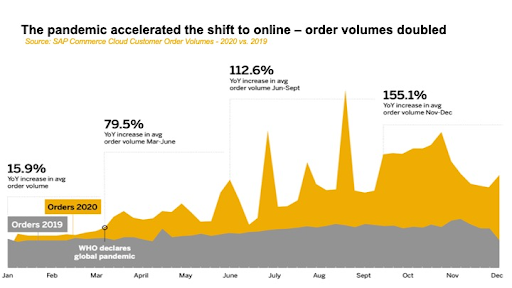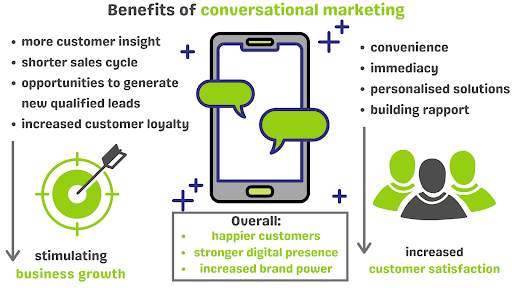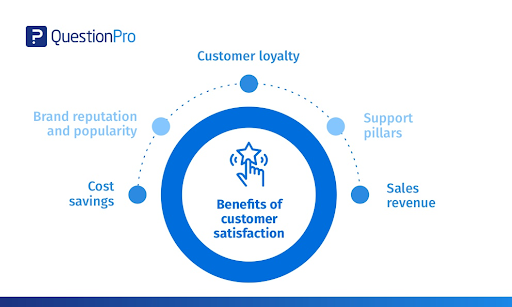The Covid-19 pandemic has transformed the future of purchasing products and services significantly. With high streets falling stagnant and a new wave of e-commerce based alternatives, the ‘personal touch’ that once came with walking into a store has begun to fade.

(Source: The Future Of Commerce)
Covid-19 has boosted the e-commerce market by 35% since the onset of the pandemic in 2020. With more competitors than ever before, online businesses have had to adapt to the needs of a digitally native audience.
From viral paid social campaigns to clever UX design, each company has tried to stand out amongst the rest. However, in their endeavour to win over a large online audience, most e-commerce giants have forgotten one vital strategy. The power of conversation and connection.
A recent study by McKinsey & Company revealed that over 80% of American shoppers value personalisation during the purchasing experience. Mimicking the traditional format of a one-to-one shopkeeper to customer balance has been proven to improve customer retention and make them feel valued when purchasing a product.
Better still, personalization not only benefits the customer but the business as well. Creating a pattern of positive customer experience yields 20% in customer satisfaction ratings and a 15% boost in sales conversions, ultimately setting you apart from your competitors.
The question is, how can you carry a personalized customer strategy forwards as your business moves into e-commerce? The answer is conversational marketing.
What Is Conversational Marketing?
Conversational marketing is all about taking the format of face-to-face interaction and applying it to the type of service you provide online. Instead of leveraging large consumer platforms such as Facebook and Instagram to project a message to the millions. Conversational marketing focuses on speaking directly to the consumer and providing one-to-one customer service.

(Image Source: Chatbots Magazine)
While this form of marketing strategy may seem time-consuming, its benefits weigh out the costs. Using time and resources to capture and build on leads is much more likely to evolve into a sale than a mass marketing campaign that targets only the surface of your demographic.
Implementing conversational marketing solutions such as chat-bots, customer feedback based tech and an in-person sales team can improve B2C customer relationships and provide a closer look into your target demographic.
Getting to know your customers will not only secure their sales but many others as well. When you prioritize personalization, you will get a better picture of your target leads. This aids the creation of successful social campaigns and re-targeting tactics.
Read on to find out how you can incorporate this strategy into your marketing plan.
What Are The Benefits Of Conversational Marketing?
Conversational marketing’s growing number of benefits are quickly catching the attention of smart marketers.

(Image Source: GRM Digital)
Here are four of the most positive changes businesses have seen after implementing conversational marketing into their e-commerce strategy.
Increased Conversion Rates
Conversational marketing is known for boosting conversion rates and turning potential leads into definite sales. You know all the organic site traffic you’ve fought so hard to gather? Well, conversational marketing could be the key to making your customers stick. Using conversational tools such as chatbots has a much higher rate of engagement than a submission form alone. This encourages customers to express their potential concerns. They will also receive instant feedback 24/7, therefore improving customer service.
This improves customer experience and boosts that CRO as web visitors are much more likely to progress to the checkout, knowing that their questions and concerns are answered.
Customer Satisfaction
Customer satisfaction is also a key benefit associated with conversational marketing and often the driving force for successful e-commerce sales.
Consumers say that it is the purchasing experience that often leaves a lasting impression. Therefore, improving customer experience is vital, if you want to see those conversion rates rise.
Conversational marketing is a great way to improve customer retention. Using methods of one-to-one communication to help develop a lead, makes the customer feel heard and most importantly valued, encouraging them to return for future purchases.

(Image Source: QuestionPro)
In fact, a recent Salesforce survey revealed that 76% of consumers believe that customer service is the true test of how much a company values them, and are five times more likely to repurchase if they have received positive service throughout their buying experience.
Learn About Your Customers
One of the most vital components of a successful marketing plan is detailed user research and testing. Whether you’re putting your UX design to the test or using detailed traffic monitoring software such as Finteza to aid strategy planning, gathering customer based info will give you a better understanding of your target demographic going forward.
Conversational marketing allows you to perform user research at a deeper level. Rather than simply surveying potential customers, you can speak directly with confident sales leads. Listening to your customers will give you a better understanding of the key factors that make up your demographic. This will aid your future campaigns as you explore your niche.
Personalise Your Solutions
The best thing about personalising your marketing outreach is the fact that you can also personalise your solutions too.
Hearing feedback in real-time makes it easier to personalise the solution for your customer’s problem. Utilising chatbots, sales representatives and interactive forms in real-time gives you the ability to modify your services and create the best match for success.
For example, if a customer is unsure about the service you’re selling, you can use conversational marketing to offer them a personalised solution. This could be a free trial or a percentage off of their first payment. Offering these personal touches not only contributes to customer satisfaction but are more likely to encourage a repurchase or long time subscription.
Customers want to see that you are flexible and adaptable to their needs. Make them feel like a big fish in a little pond and you will see your sales targets soaring.
How To Implement Conversational Marketing Into Your Strategy
Implementing conversational marketing into your e-commerce strategy has never been easier. Here are some of the simplest ways to integrate personalisation into your B2C future.
- Chatbots: If you want to remain active for your consumers 24/7, chatbots are a great way to encourage conversation about your products and services. A bot can easily process a number of requests at once and provide personalised service for each problem. This boosts sales conversions and breaks potential barriers.
- Invest In A Sales Team: While it may seem like a costly investment at the time, investing your budget into a real-life customer service team will provide you with a significant ROI. Personally following up on sales leads both on the phone and within an email, format mimics the face-to-face contact that buyers receive in-store.
- Head To Social Media: While prioritising website conversions may be your primary goal, with 4.4 billion users, most of your demographic is likely on social media too. Implementing social listening tactics into your strategy can make it easier to speak to potential sales leads and reply to brand mentions outside of your online store.
Ready To Start The Conversation?
For new e-commerce businesses on the block, conversational marketing could be the key to your success. Known to reduce sales and marketing costs by 10-20%, this unique form of strategy is taking business tactics back to traditional selling methods. Why not incorporate it into your marketing plan and watch your sales skyrocket?
The post Conversational Marketing: Boosting Revenue and Improving Customer Experience appeared first on ReadWrite.


Comentarios recientes